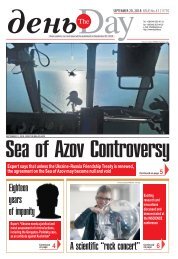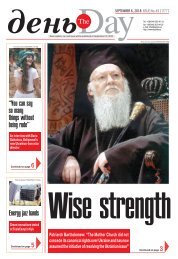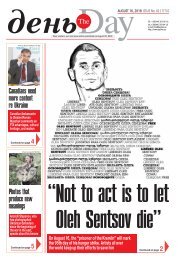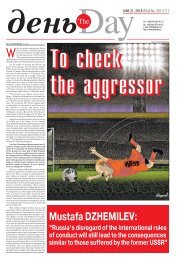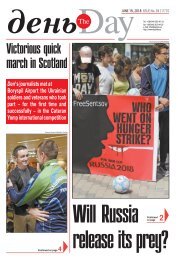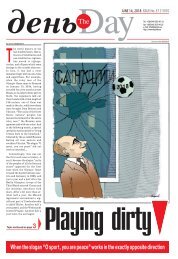41_1-8
Create successful ePaper yourself
Turn your PDF publications into a flip-book with our unique Google optimized e-Paper software.
WWW.DAY.KIEV.UA<br />
CULT URE No.<strong>41</strong> AUGUST 9, 2018 5<br />
ing island can theoretically be made in this<br />
water lens. You can extract some oxygen<br />
and nitrogen out of it, while ammonia is already<br />
available there, – so you can live.<br />
Jupiter shines above you through the ice,<br />
and the Sun glows far away.<br />
“And it turned out in 2012 that Europa<br />
has not only water, but also fissures<br />
through which it is ejected into the surrounding<br />
space – geysers. This means water<br />
is in fact on the surface. If you search<br />
for life at 12-kilometer intervals, you’ll<br />
have to drill very much. But if there are<br />
such geysers, you just fly by, quickly grab<br />
a few kilograms of this water, pack it into<br />
a container, and examine whether there<br />
is life on Europa.”<br />
● “LYING LOW” ON MERCURY<br />
If people wished to live somewhere<br />
else, which celestial body should they begin<br />
with?<br />
“Three colleagues of mine and I spoke<br />
at the ‘Astronomical School of Young Scientists’<br />
about where to search for life and<br />
which territories to choose for living in.<br />
The first conclusion is: man must not be exposed<br />
to asteroid-related danger and must<br />
live on Earth only. It is necessary to carry<br />
out the so-called repopulation. For example,<br />
we choose a few asteroids. There are<br />
about 5,000 asteroids now, which periodically<br />
come close to Earth. We have selected<br />
several dozen asteroids two to three kilometers<br />
in diameter, which have water,<br />
iron, silicon, and other mineral resources.<br />
Some of them fly circles and others have<br />
elongated orbits and periodically fly near<br />
Earth or near the chosen asteroids that fly<br />
circles. Accordingly, we land on such an asteroid,<br />
bury ourselves under its surface,<br />
disengage oxygen from water, and colonize<br />
this celestial body. When we launch a couple<br />
of dozen of such stations, we will have<br />
dozens of what may be called fixed-route<br />
taxis for communication with Earth.<br />
“We believe it is possible to ‘get on’<br />
some asteroid that is flying into the direction<br />
we need, fly up to another one and<br />
land on it. You don’t have to fly millions<br />
of kilometers – instead, you calculate a moment<br />
to fly up to your final destination on<br />
an ‘asteroid taxi’ and then you transfer, so<br />
to speak, from one asteroid to another in<br />
just a few days on a small spacecraft.<br />
“For a longtime colonization, it’s necessary<br />
to choose asteroids that have nickel-iron<br />
ore, extractable water, and rare<br />
chemical elements. There is even gold and<br />
platinum on some. In this case you can easily<br />
live and work in their caves, extract mineral<br />
resources, and produce the goods humankind<br />
needs. ‘Taxi managers,’ life support<br />
personnel, etc., will stay there permanently,<br />
while narrow specialists needed<br />
for a given asteroid factory may well work<br />
on a rotational basis. Naturally, there<br />
should be permanent communication between<br />
stations. Two or three dozens of<br />
such space ‘fixed-route taxis’ will be enough<br />
to colonize the space from Earth, through<br />
the asteroid belt, up to Jupiter. And after<br />
living there for several years, people get<br />
back to Earth, and we examine changes in<br />
their organism and decide whether or not<br />
we can move there for good.<br />
“The second place is the abovementioned<br />
Europa and a few more moons of<br />
Jupiter and Saturn. Europa is very close to<br />
Jupiter. Its magnetic field is too strong for<br />
us, and we may be exposed to excessive radiation.<br />
So we should reach Europa and immediately<br />
get under the ice, where there is<br />
good water – please swim and bathe<br />
(laughs). There is also Ganymede, an icy<br />
moon of Jupiter, which is farther away<br />
from that planet. There’s less radiation<br />
there and enough water. There are three or<br />
four objects around Saturn, which can also<br />
be colonized. And, quite unexpectedly,<br />
it is Venus.”<br />
It is sultry there – more than 400 degrees<br />
Celsius on the surface…<br />
“Yes, but temperature varies from<br />
zero to +30 Celsius at the altitude of 50-60<br />
kilometers. The pressure is one atmosphere.<br />
But atmosphere consists of carbon<br />
dioxide. On the other hand, this gas includes<br />
oxygen – so take it, break down, and<br />
isolate oxygen. Moreover, there’s also a lot<br />
of water vapor, and it’s possible to extract<br />
nitrogen. Now let us imagine: if you make<br />
a ball one kilometer in diameter, fill it with<br />
a mixture of nitrogen and oxygen or, as the<br />
Americans do in their spacecraft, helium<br />
and oxygen, the inner and outer pressure<br />
will be the same – one atmosphere. Yet the<br />
Earth-type atmosphere will be slightly<br />
lighter than the outer one. Besides, our ball<br />
has certain buoyancy. About a hundred<br />
thousand people can settle there in several<br />
tiers. Gravitational acceleration, which<br />
is 9.8 meters per second on Earth, is 8.9<br />
there – very close. Your bones will be intact,<br />
no osteochondrosis at all (laughs). So<br />
this is an interesting object of colonization.<br />
“And here is one more option. Scientist<br />
Oleksii Steklov has calculated depth-related<br />
temperature changes on various bodies. For<br />
example, it is quite hot on Mercury [340<br />
Kelvin degrees. – Author]. But Mercury’s<br />
axis has no tilt and does not vary<br />
with rotation. There are a lot of craters at<br />
the poles, where the Sun never shines, and<br />
the temperature there is 90 K or much less.<br />
There is even water there, for comet nuclei,<br />
which almost completely consist of ice, used<br />
to fall in those areas. It is estimated that<br />
frozen water will suffice for millions of<br />
years there. And temperature is always<br />
from zero to +20 degrees at the depth of only<br />
three to thirty meters. So it is always<br />
warm in the polar regions – from the latitude<br />
of 70 degrees up to the poles. There’s<br />
water next to you. So you’re welcome to<br />
hide at a low depth, live, watch the Sun, and<br />
warn terrestrials if there’s been a major<br />
flare on it.”<br />
● LIGHTNING AND CHANGE<br />
OF SEASONS ON JUPITER<br />
You have explored Jupiter and Saturn<br />
very much. Lightning occurs in Jupiter’s<br />
atmosphere much more often than on<br />
Earth. To what extent does it resemble<br />
ours?<br />
“Lightning on Jupiter somewhat resembles<br />
the one I saw in Kyiv the other day.<br />
We have seen nothing of the sort for a long<br />
time. The Dnieper flows six kilometers or<br />
so from the observatory, and the sky is<br />
clouded there, but here something seems to<br />
be roaring in the sky all the time. This has<br />
been happening continuously. Usually,<br />
thunder booms, lightning strikes, and<br />
that’s all. But here it was roaring for almost<br />
an hour. Almost the same occurs on<br />
Jupiter – multiple-discharge lightning<br />
can ‘roar’ for 40-50 hours in a row. There<br />
are also the so-called continuous flashes.<br />
For example, the Galileo spacecraft recorded<br />
that something like lightning shone all<br />
the time at a 1,000 by 300 kilometers<br />
place, and this lasted for years.”<br />
You were the first to record natural oscillations<br />
in the atmospheres of Jupiter<br />
and Saturn, and then you and your colleagues<br />
found seasonal changes in the atmospheres<br />
of those planets. Can these<br />
seasonal changes be compared with those<br />
on Earth?<br />
“There are seasons on Earth owing to<br />
the tilt of the terrestrial axis – 23.44 degrees.<br />
The axis of Saturn is tilted by<br />
26.7 degrees. There are seasonal changes<br />
there as well, but you must watch them<br />
very long because the period of this planet’s<br />
revolution around the Sun is 29 something<br />
years [29.46 years. – Author]. We discovered<br />
and registered them. Jupiter’s<br />
period of revolution is 11.86 years. It<br />
took us seven years to see that there can be<br />
seasonal changes there, and we recorded a<br />
difference between summers in the southern<br />
and northern hemispheres. But the tilt<br />
of Jupiter’s axis is three degrees only.<br />
Whence is the change of seasons? We<br />
found that the magnetic and the geographic<br />
axes form an angle of 12 something<br />
degrees. For this reason, if you add these 12<br />
to the three-degree tilt, you will have 15.<br />
And the situation will be just the reverse<br />
six terrestrial years, or Jupiter’s six<br />
months, later. This means that the geographic<br />
and the magnetic poles have the<br />
same impact as geographic inclination<br />
alone has in our case.<br />
“As we examined the upper layers of<br />
Jupiter’s atmosphere, it turned out that<br />
3 plus 12 degrees of tilt are enough to bring<br />
about seasonal changes. Besides, the orbit<br />
is more elongated that that of Earth.<br />
When Jupiter’s northern hemisphere is<br />
closest to the Sun, it receives 40 percent<br />
more heat than it will do six years later,<br />
when the southern hemisphere is exposed<br />
to solar rays. This alone is supposed to trigger<br />
changes in the atmosphere, and we<br />
recorded them.”<br />
Read more on our website<br />
THAT’S HOW THE ZVENYHOROD PARK IS GOING TO LOOK LIKE<br />
Princely Zvenyhorod to be revived<br />
Scholars are launching<br />
a historical-cultural park in Lviv region<br />
By Oksana HRUBA, Lviv<br />
Photos by Vitalii HRABAR<br />
Ukraine’s first historicalcultural<br />
park “Ancient<br />
Zvenyhorod” will be launched<br />
in autumn not far from<br />
Lviv, based on a nationwide<br />
archeological site. It will cover an<br />
area of approximately 38 hectares. The<br />
project is a brainchild of the<br />
Department of Architecture and<br />
Urban Development at Lviv Oblast<br />
State Administration. The project<br />
won in the competition of the regional<br />
development initiatives. Approximately<br />
12 million hryvnias will be<br />
allotted for its implementation within<br />
the EU sector budget support<br />
program. The project envisages the<br />
regularization of the site and the<br />
central square of the village,<br />
conservation of the sites of the<br />
principality time with the aim to<br />
preserve them for future research,<br />
marking the most significant<br />
buildings of the principality time with<br />
the help of modern artistic and<br />
technical means, laying out the roads<br />
of the ancient settlement with the<br />
purpose of outlining the late medieval<br />
and early medieval fortifications, the<br />
visual reconstruction of the unique<br />
defense system of the 18th century,<br />
creating the basic touristic<br />
infrastructure around the historicalcultural<br />
park “Ancient Zvenyhorod,”<br />
tourist routes, etc.<br />
Zvenyhorod was one of three<br />
capitals of the principality, where<br />
the Ukrainian statehood emerged in<br />
11th and 12th centuries in the Transcarpathian<br />
region. According to<br />
archeologists, the research of<br />
Zvenyhorod started back in the mid-<br />
19th century and is still underway.<br />
The largest excavations took place<br />
in the 1950s-1990s. The impressive<br />
collection of the archeological artifacts<br />
that counts for tens thousands<br />
of findings, shows Zvenyhorod as a<br />
big economic, cultural, and spiritual<br />
center.<br />
THE ZVENYHOROD MUSEUM DISPLAYS OVER 300 ITEMS DATED 11th-12th CENTURIES<br />
The co-author of the project, a<br />
Zvenyhorod researcher, junior researcher<br />
at the Archeological Rescuing<br />
Service Nataliia VOITSE-<br />
SHCHUK commented to The Day:<br />
“The question of launching a preserve<br />
in Zvenyhorod was raised after<br />
the collapse of the Soviet Union. But<br />
while the documents were drafted in<br />
1995 Ihor Svieshnikov, who was the<br />
mastermind and the moving force of<br />
the process, died. In the 1990s the<br />
preserves in Halych and Belz were<br />
launched, however a different fate<br />
awaited Zvenyhorod. But I think<br />
history doesn’t like unfinished cycles,<br />
and now the time has come for<br />
me and our team with the support of<br />
concerned citizens to create this<br />
touristic-cultural and educational<br />
center. We have already applied the<br />
documents and are waiting for the<br />
decision. Last year, not to waste our<br />
time, we filed a project application<br />
for the grant program for the adaptation<br />
of the sites of cultural heritage<br />
for tourist activity. And we decided<br />
to create a preserve. But the<br />
question is not about just launching<br />
a preserve, but continuing to develop<br />
it. Because we already have the<br />
preserves that remain only as the<br />
names on the administrative map.<br />
We have no preserve yet, but we<br />
have the opportunity to bring the<br />
territory in order, so we have decided<br />
to launch a park. This will be a<br />
recreational area with tourism as its<br />
main activity. The park will conserve<br />
and preserve the site with minimum<br />
intrusion into its historical<br />
landscape, we are not planning any<br />
construction, we will only renew the<br />
external borders of the fortifications<br />
that have been preserved.<br />
While walking in the park, the person<br />
will learn the interesting facts<br />
from the history of the Zvenyhorod<br />
Principality, and partially it will be<br />
done through the game, because the<br />
project is meant not only for adults,<br />
but for children as well. We want to<br />
create a competitive tourist project<br />
in the Ukrainian market to fulfill<br />
the main task, preserving the site<br />
for the future generations,” Voitseshchuk<br />
says.<br />
“We’ve made a film about the<br />
history of Zvenyhorod, from ancient<br />
time till today. We’ve also launched<br />
an exhibit at the Zvenyhorod Museum<br />
to make people learn about our<br />
town of the principality time, it’s<br />
called ‘Ancient Zvenyhorod – coming<br />
back from oblivion’ and showcases<br />
over 300 items from the 11th-12th<br />
centuries. It will be open till December<br />
1. There are very few archeological<br />
exhibits, as this is a very specific<br />
sphere of museum activity, because<br />
it’s not easy to display the archeological<br />
items, moreover to add some informational<br />
background. We display<br />
the most interesting items from historical<br />
viewpoint, which were found<br />
in Zvenyhorod in the period between<br />
the 19th century and 2010, when the<br />
last excavations took place. Most of<br />
the items were found during the significant<br />
studies, which lasted in the<br />
period between 1971 and 1986, the<br />
boyar quarter which was excavated<br />
to more than a half. Unique remains<br />
of a wooden building, which had been<br />
well preserved due to the qualities of<br />
the peat soil as a conserver of organic<br />
materials, were found there,” Nataliia<br />
specifies.<br />
Certainly, the touristic potential<br />
and prospect of famous Zvenyhorod<br />
are huge, but, most importantly, the<br />
scholars must start<br />
regularizing and<br />
framing it on a serious<br />
level. Voitseshchuk<br />
states: “Unfortunately,<br />
we have<br />
no favorable conditions<br />
to implement<br />
cultural and historical<br />
projects. Culture<br />
is the last thing to be<br />
cared about. We must<br />
change the approach,<br />
there must be an exploration<br />
with the vision<br />
of ourselves and<br />
understanding why<br />
we are doing this.<br />
And there should be<br />
the understanding<br />
that either you make a<br />
high-quality product<br />
and compete or you<br />
cease to exist. Actually,<br />
there must be a<br />
professional academic<br />
management.”




